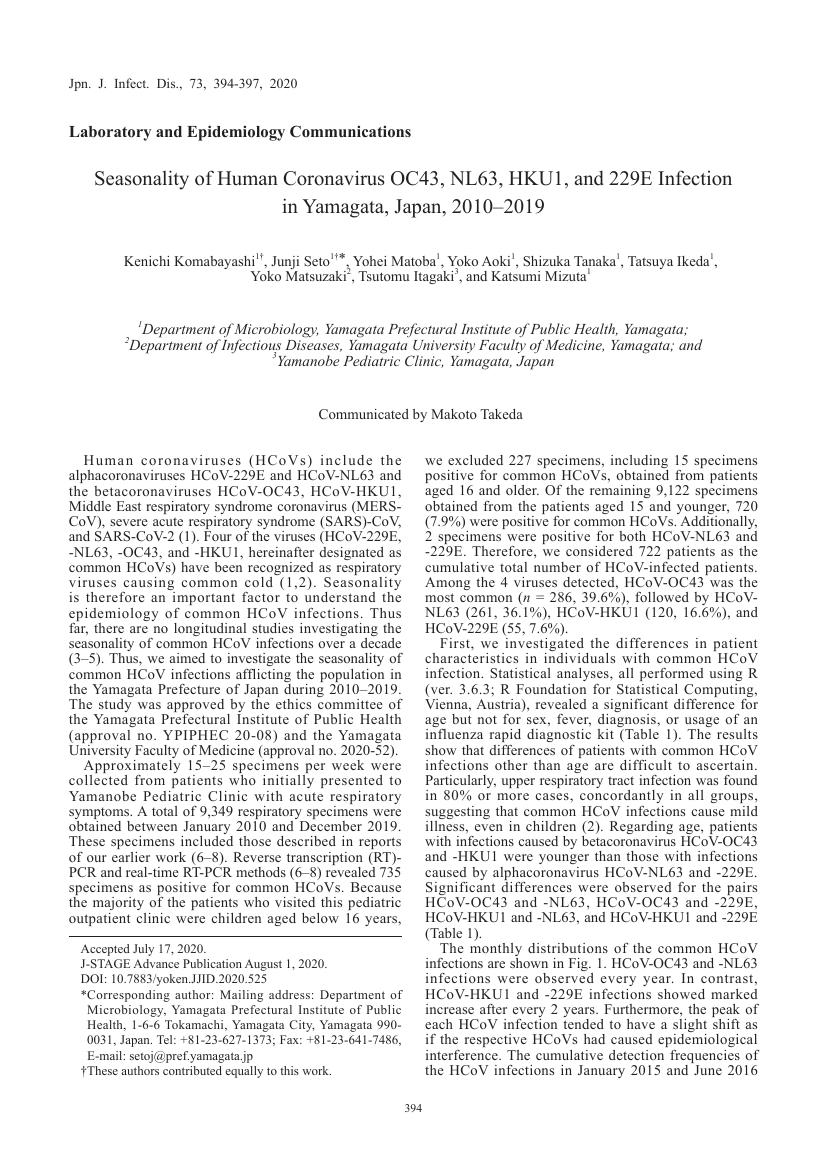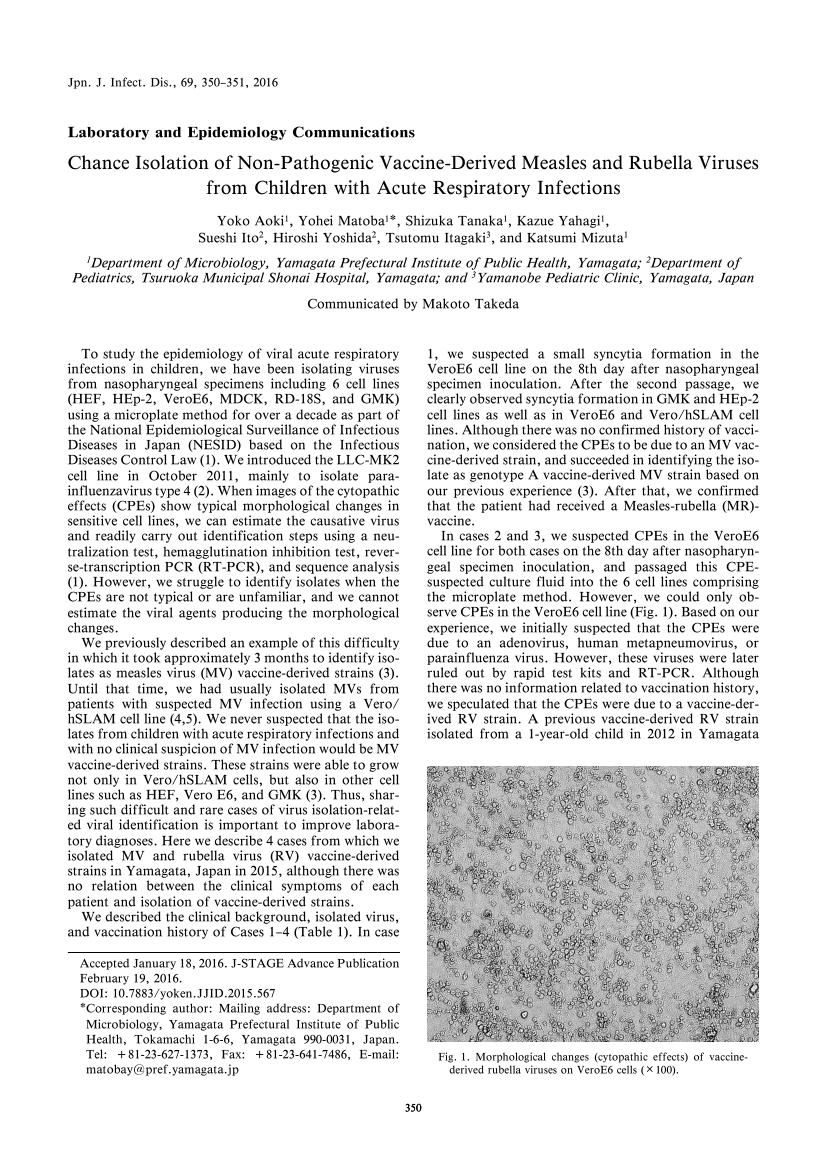49 0 0 0 OA Seasonality of human coronavirus OC43, NL63, HKU1, and 229E infection in Yamagata, Japan, 2010–2019
- 著者
- Kenichi Komabayashi Junji Seto Yohei Matoba Yoko Aoki Shizuka Tanaka Tatsuya Ikeda Yoko Matsuzaki Tsutomu Itagaki Katsumi Mizuta
- 出版者
- National Institute of Infectious Diseases, Japanese Journal of Infectious Diseases Editorial Committee
- 雑誌
- Japanese Journal of Infectious Diseases (ISSN:13446304)
- 巻号頁・発行日
- pp.JJID.2020.525, (Released:2020-08-01)
- 参考文献数
- 10
- 被引用文献数
- 1 18
- 著者
- Kenichi Komabayashi Junji Seto Shizuka Tanaka Yu Suzuki Tatsuya Ikeda Noriko Onuki Keiko Yamada Tadayuki Ahiko Hitoshi Ishikawa Katsumi Mizuta
- 出版者
- National Institute of Infectious Diseases
- 雑誌
- Japanese Journal of Infectious Diseases (ISSN:13446304)
- 巻号頁・発行日
- vol.71, no.6, pp.413-418, 2018-11-30 (Released:2018-11-22)
- 参考文献数
- 26
- 被引用文献数
- 28 35
The incidence of modified measles (M-Me), characterized by milder symptoms than those of typical measles (T-Me), has been increasing in Japan. However, the outbreak dominated by M-Me cases has not been thoroughly investigated worldwide. The largest importation-related outbreak of measles with genotype D8 occurred in Yamagata Prefecture, Japan, from March to April 2017. This phenomenon was observed after Japan had achieved measles elimination in 2015. We confirmed 60 cases by detecting the genome of the measles virus (MeV). Among the cases, 38 were M-Me and 22 were T-Me. Thirty-nine (65.0%) patients were 20–39 years of age. Three out of 7 primary cases produced 50 transmissions, of which each patient caused 9–25 transmissions. These patients were 22–31 years old and were not vaccinated. Moreover, they developed T-Me and kept contact with the public during their symptomatic periods. Considering that M-Me is generally caused by vaccine failure, some individuals in Japan may have insufficient immunity for MeV. Accordingly, additional doses of measles vaccine may be necessary in preventing measles importation and endemicity among individuals aged 20–39 years. Furthermore, to accurately and promptly diagnose individuals with measles, particularly those who can be considered as primary cases, efforts must be exerted to detect all measles cases using epidemiological and genetic approaches in countries where measles elimination had been achieved.
9 0 0 0 OA Seasonality of Human Coronavirus OC43, NL63, HKU1, and 229E Infection in Yamagata, Japan, 2010–2019
- 著者
- Kenichi Komabayashi Junji Seto Yohei Matoba Yoko Aoki Shizuka Tanaka Tatsuya Ikeda Yoko Matsuzaki Tsutomu Itagaki Katsumi Mizuta
- 出版者
- National Institute of Infectious Diseases, Japanese Journal of Infectious Diseases Editorial Committee
- 雑誌
- Japanese Journal of Infectious Diseases (ISSN:13446304)
- 巻号頁・発行日
- vol.73, no.5, pp.394-397, 2020-09-30 (Released:2020-09-24)
- 参考文献数
- 10
- 被引用文献数
- 2 18
- 著者
- Yohei Matoba Yoko Aoki Shizuka Tanaka Kazue Yahagi Yuriko Katsushima Fumio Katsushima Kanetsu Sugawara Yoko Matsuzaki Katsumi Mizuta
- 出版者
- National Institute of Infectious Diseases, Japanese Journal of Infectious Diseases Editorial Committee
- 雑誌
- Japanese Journal of Infectious Diseases (ISSN:13446304)
- 巻号頁・発行日
- vol.69, no.5, pp.452-454, 2016 (Released:2016-09-21)
- 参考文献数
- 11
- 被引用文献数
- 4 15
- 著者
- Katsumi Mizuta Waka Tanaka Kenichi Komabayashi Shizuka Tanaka Junji Seto Yoko Aoki Tatsuya Ikeda
- 出版者
- National Institute of Infectious Diseases, Japanese Journal of Infectious Diseases Editorial Committee
- 雑誌
- Japanese Journal of Infectious Diseases (ISSN:13446304)
- 巻号頁・発行日
- vol.72, no.4, pp.211-223, 2019 (Released:2019-07-24)
- 参考文献数
- 102
- 被引用文献数
- 12 10
We introduced a microplate method for virus isolation in the Department of Microbiology, Yamagata Prefectural Institute of Public Health (YPIPH) in 1999 in Yamagata, Japan. We have since carried out longitudinal epidemiological studies on viral infectious diseases, particularly respiratory viruses, combining traditional technologies such as virus isolation and serological techniques and newly developed molecular methods. Here, we provide an overview of our activities at YPIPH between 1999 and 2018. During the study period, we observed emerging and re-merging diseases such as those caused by echovirus type 13, enterovirus D68, parechovirus-A3 (PeV-A3), and Saffold virus. With regard to PeV-A3, we proposed a new disease concept, “PeV-A3-associated myalgia/myositis.” We also revealed the longitudinal epidemiologies of several viruses such as enterovirus A71 and coxsackievirus A16. To perform longitudinal epidemiological studies at any time in Yamagata, we established a system for stocking clinical specimens, viral isolates, complementary DNAs, and serum specimens. We have also pursued collaboration works with virology laboratories across Japan. We hope our experiences, findings, and research materials will further contribute to the development of countermeasures against viral infectious diseases and improvement in public health strategies in Yamagata, Japan, Asia, and around the world.
- 著者
- Yoko Aoki Yohei Matoba Shizuka Tanaka Kazue Yahagi Sueshi Ito Hiroshi Yoshida Tsutomu Itagaki Katsumi Mizuta
- 出版者
- 国立感染症研究所 Japanese Journal of Infectious Diseases 編集委員会
- 雑誌
- Japanese Journal of Infectious Diseases (ISSN:13446304)
- 巻号頁・発行日
- vol.69, no.4, pp.350-351, 2016 (Released:2016-07-22)
- 参考文献数
- 7
- 被引用文献数
- 5



